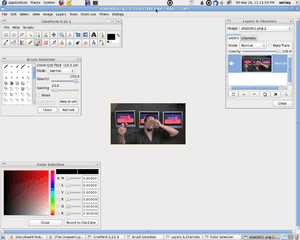CinePaint
CinePaint is an open source computer program for painting and retouching bitmap frames of films. It is a fork of version 1.0.4 of the GNU Image Manipulation Program (GIMP). It enjoyed some success as one of the earliest open source tools developed for feature motion picture visual effects and animation work.[2] The main reason for this adoption over mainline gimp was its support for high bit depths (greater than 8-bits per channel) which can be required for film work. The mainline GIMP project later added high bit depths in GIMP 2.9.2, released November 2015.[3] It is free software under the GNU General Public License.
 | |
| Stable release | 1.0-4
/ April 9, 2012[1] |
|---|---|
| Repository | |
| Written in | C, C++ |
| Operating system | Unix-like |
| Type | Graphics |
| License | GNU General Public License |
| Website | www |
Main features
Features that set CinePaint apart from its photo-editing predecessor include the frame manager, onion skinning, and the ability to work with 16-bit and floating point pixels for high dynamic range imaging (HDR). CinePaint supports a 16-bit color managed workflow for photographers and printers, including CIE*Lab and CMYK editing. It supports the Cineon, DPX, and OpenEXR image file formats. HDR creation from bracketed exposures is easy.
CinePaint is a professional open-source raster graphics editor, not a video editor. Per-channel color engine core: 8-bit, 16-bit, and 32-bit. The image formats it supports include BMP, CIN, DPX, EXR, GIF, JPEG, OpenEXR, PNG, TIFF, and XCF.
CinePaint is currently available for UNIX and Unix-like OSes including Mac OS X and IRIX. The program is available on Linux, Mac OS X, FreeBSD and NetBSD. Its main competitors are the mainline GIMP and Adobe Photoshop, although the latter is only available for Mac OS X and Microsoft Windows. Glasgow, a completely new code architecture being used for CinePaint, is expected to make a new Windows version possible and is currently under production. The Glasgow effort is FLTK based.[4] This effort appears to have stalled.[5]
Movies
Examples of the software's application in the movie industry include[6]:
- Elf (2003)
- Looney Tunes: Back in Action (2003)
- League of Extraordinary Gentlemen (2003)
- Duplex (2003)
- The Last Samurai (2003)
- Showtime (2002)
- Blue Crush (2002)
- 2 Fast 2 Furious (2003)
- The Harry Potter series
- Cats & Dogs (2001)
- Dr. Dolittle 2 (2001)
- Little Nicky (2000)
- The Grinch (2000)
- The 6th Day (2000)
- Stuart Little (1999)
- Planet of the Apes (2001)
- Stuart Little 2 (2002)
- Spider-Man (2002)
Under its former name Film Gimp, CinePaint was used for films such as Scooby-Doo (2002), Harry Potter and the Philosopher's Stone (2001), The Last Samurai (2003) and Stuart Little (1999).[7]
References
- "CinePaint — Open source deep paint software". Cinepaint.org. Retrieved May 8, 2013.
- Robin Rowe (February 17, 2005). "The Linux Motion Picture Pipeline". LinuxMovies.org. Archived from the original on July 16, 2007. Retrieved July 29, 2007.
- "User's Guide to High Bit Depth GIMP 2.9.2". November 2015. Retrieved December 10, 2015.
- "CinePaint Documentation: Why Migrate from GTK to FLTK". Retrieved March 10, 2008.
- "cinepaint.org".
- "Old CinePaint about page".
- "CinePaint "About" page".
External links
- Official website Mostly dead links and seems unmaintained.
- CinePaint Wiki and downloads
- 16-bit imaging. From digital camera to print a colour management tutorial
- Basic color management for X (linux.com)
- High Dynamic Range images under Linux (linux.com)
- GIMP and Film Production